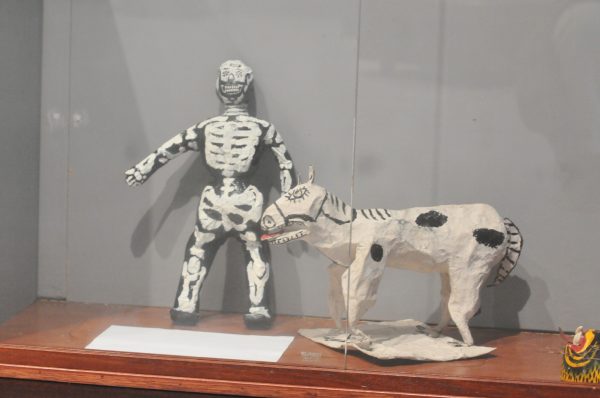ONLINE EXCLUSIVE: What to do before, during and after an earthquake
It’s true. No one can predict when the next earthquake will happen. However, one thing people can do is be prepared and know what to do before, during an after an earthquake. Make sure to also check out our debunking earthquake myths story to learn what not to do during an earthquake.
Here are a few suggestions from the Ready.Gov website.
Before
- Build an emergency kit and have a family communication plan. That includes having a meeting place, somewhere that all family members will meet once it’s safe to move around.
- Fasten shelves to insure that they are secure to walls.
- Place large or heavy objects on lower shelves. This will avoid them from falling and hurting someone.
- Store breakable items such as bottled foods, glass, and china in low, closed cabinets with latches.
- Fasten heavy items such as pictures and mirrors securely to walls and away from beds, couches and anywhere people sit.
- Brace overhead light fixtures and top heavy objects.
- Repair defective electrical wiring and leaky gas connections. These are potential fire risks. Get appropriate professional help. Do not work with gas or electrical lines yourself.
- Install flexible pipe fittings to avoid gas or water leaks. Flexible fittings are more resistant to breakage.
- Secure your water heater, refrigerator, furnace and gas appliances by strapping them to the wall studs and bolting to the floor. If recommended by your gas company, have an automatic gas shut-off valve installed that is triggered by strong vibrations.
- Repair any deep cracks in ceilings or foundations. Get expert advice if there are signs of structural defects.
- Be sure the residence is firmly anchored to its foundation.
- Store weed killers, pesticides, and flammable products securely in closed cabinets with latches and on bottom shelves.
- Locate safe spots in each room under a sturdy table or against an inside wall. Reinforce this information by moving to these places during each drill.
- Hold earthquake drills with your family members: Drop, cover and hold on.
During
If Indoors
- DROP to the ground; take COVER by getting under a sturdy table or other piece of furniture; and HOLD ON until the shaking stops. If there isn’t a table or desk near you, cover your face and head with your arms and crouch in an inside corner of the building.
- Stay away from glass, windows, outside doors and walls, and anything that could fall, such as lighting fixtures or furniture.
- Stay in bed if you are there when the earthquake strikes. Hold on and protect your head with a pillow, unless you are under a heavy light fixture that could fall. In that case, move to the nearest safe place.
- Do not use a doorway except if you know it is a strongly supported, load-bearing doorway and it is close to you. Many inside doorways are lightly constructed and do not offer protection..
- Stay inside until the shaking stops and it is safe to go outside. Do not exit a building during the shaking. Research has shown that most injuries occur when people inside buildings attempt to move to a different location inside the building or try to leave.
- DO NOT use the elevators.
- Be aware that the electricity may go out or the sprinkler systems or fire alarms may turn on.
If Outdoors
- Stay there.
- Move away from buildings, streetlights, and utility wires.
- Once in the open, stay there until the shaking stops. The greatest danger exists directly outside buildings, at exits and alongside exterior walls. Many of the 120 fatalities from the 1933 Long Beach earthquake occurred when people ran outside of buildings only to be killed by falling debris from collapsing walls. Ground movement during an earthquake is seldom the direct cause of death or injury. Most earthquake-related casualties result from collapsing walls, flying glass, and falling objects.
If in a Moving Vehicle
- Stop as quickly as safety permits and stay in the vehicle. Avoid stopping near or under buildings, trees, overpasses, and utility wires.
- Proceed cautiously once the earthquake has stopped. Avoid roads, bridges, or ramps that might have been damaged by the earthquake.
If Trapped Under Debris
- Do not light a match.
- Do not move about or kick up dust.
- Cover your mouth with a handkerchief or clothing.
- Tap on a pipe or wall so rescuers can locate you. Use a whistle if one is available. Shout only as a last resort. Shouting can cause you to inhale dangerous amounts of dust.
After
After an Earthquake
- When the shaking stops, look around to make sure it is safe to move. Then exit the building.
- Expect aftershocks. These secondary shockwaves are usually less violent than the main quake but can be strong enough to do additional damage to weakened structures and can occur in the first hours, days, weeks, or even months after the quake.
- Help injured or trapped persons. Remember to help your neighbors who may require special assistance such as infants, the elderly and people with access and functional needs. Give first aid where appropriate. Do not move seriously injured persons unless they are in immediate danger of further injury. Call for help.
- Look for and extinguish small fires. Fire is the most common hazard after an earthquake.
- Listen to a battery-operated radio or television for the latest emergency information.
- Be aware of possible tsunamis if you live in coastal areas. These are also known as seismic sea waves (mistakenly called “tidal waves”). When local authorities issue a tsunami warning, assume that a series of dangerous waves is on the way. Stay away from the beach.
- Use the telephone only for emergency calls.
- Go to a designated public shelter if your home had been damaged and is no longer safe. Text SHELTER + your ZIP code to 43362 (4FEMA) to find the nearest shelter in your area (example: shelter 12345).






